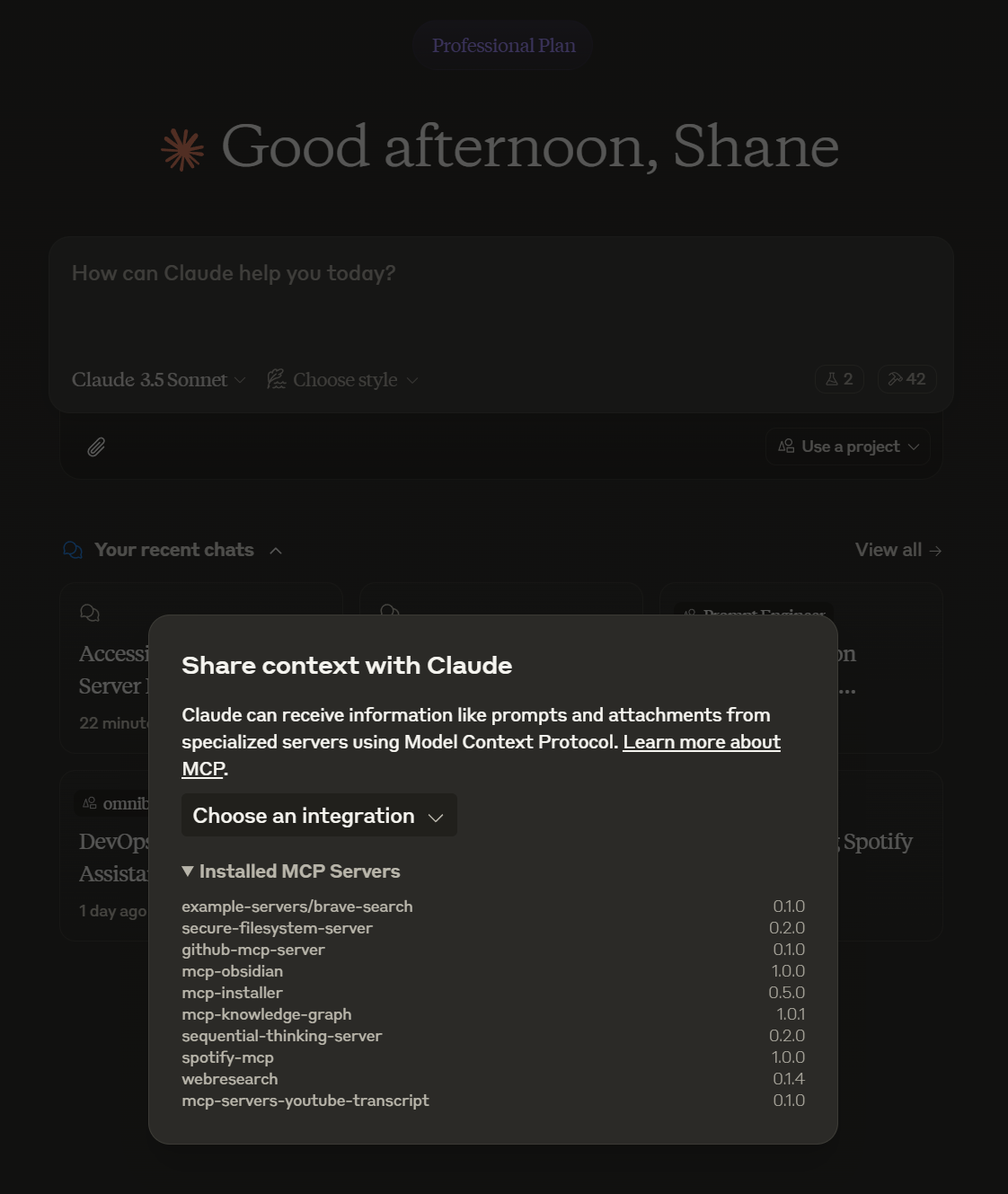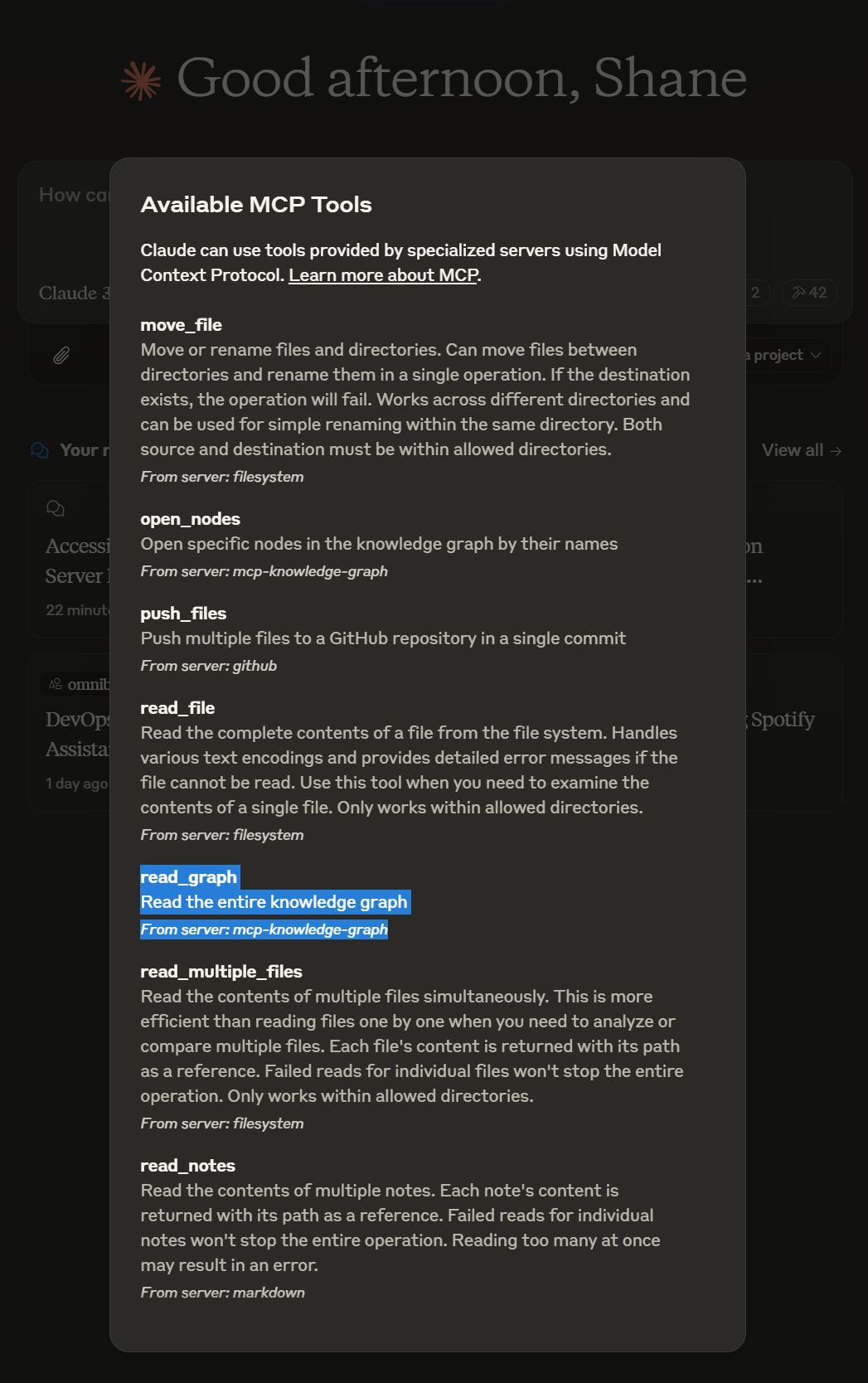MCP server enabling persistent memory for Claude through a local knowledge graph - fork focused on local development
mcp-knowledge-graph
Knowledge Graph Memory Server
An improved implementation of persistent memory using a local knowledge graph with a customizable --memory-path.
This lets AI models remember information about the user across chats. It works with any AI model that supports the Model Context Protocol (MCP) or function calling capabilities.
[!NOTE] This is a fork of the original Memory Server and is intended to not use the ephemeral memory npx installation method.
Server Name
mcp-knowledge-graph


Core Concepts
Entities
Entities are the primary nodes in the knowledge graph. Each entity has:
- A unique name (identifier)
- An entity type (e.g., "person", "organization", "event")
- A list of observations
Example:
{
"name": "John_Smith",
"entityType": "person",
"observations": ["Speaks fluent Spanish"]
}
Relations
Relations define directed connections between entities. They are always stored in active voice and describe how entities interact or relate to each other.
Example:
{
"from": "John_Smith",
"to": "ExampleCorp",
"relationType": "works_at"
}
Observations
Observations are discrete pieces of information about an entity. They are:
- Stored as strings
- Attached to specific entities
- Can be added or removed independently
- Should be atomic (one fact per observation)
Example:
{
"entityName": "John_Smith",
"observations": [
"Speaks fluent Spanish",
"Graduated in 2019",
"Prefers morning meetings"
]
}
API
Tools
-
create_entities
- Create multiple new entities in the knowledge graph
- Input:
entities(array of objects)- Each object contains:
name(string): Entity identifierentityType(string): Type classificationobservations(string[]): Associated observations
- Each object contains:
- Ignores entities with existing names
-
create_relations
- Create multiple new relations between entities
- Input:
relations(array of objects)- Each object contains:
from(string): Source entity nameto(string): Target entity namerelationType(string): Relationship type in active voice
- Each object contains:
- Skips duplicate relations
-
add_observations
- Add new observations to existing entities
- Input:
observations(array of objects)- Each object contains:
entityName(string): Target entitycontents(string[]): New observations to add
- Each object contains:
- Returns added observations per entity
- Fails if entity doesn't exist
-
delete_entities
- Remove entities and their relations
- Input:
entityNames(string[]) - Cascading deletion of associated relations
- Silent operation if entity doesn't exist
-
delete_observations
- Remove specific observations from entities
- Input:
deletions(array of objects)- Each object contains:
entityName(string): Target entityobservations(string[]): Observations to remove
- Each object contains:
- Silent operation if observation doesn't exist
-
delete_relations
- Remove specific relations from the graph
- Input:
relations(array of objects)- Each object contains:
from(string): Source entity nameto(string): Target entity namerelationType(string): Relationship type
- Each object contains:
- Silent operation if relation doesn't exist
-
read_graph
- Read the entire knowledge graph
- No input required
- Returns complete graph structure with all entities and relations
-
search_nodes
- Search for nodes based on query
- Input:
query(string) - Searches across:
- Entity names
- Entity types
- Observation content
- Returns matching entities and their relations
-
open_nodes
- Retrieve specific nodes by name
- Input:
names(string[]) - Returns:
- Requested entities
- Relations between requested entities
- Silently skips non-existent nodes
Usage with MCP-Compatible Platforms
This server can be used with any AI platform that supports the Model Context Protocol (MCP) or function calling capabilities, including Claude, GPT, Llama, and others.
Setup with Claude Desktop
Add this to your claude_desktop_config.json:
{
"mcpServers": {
"memory": {
"command": "npx",
"args": [
"-y",
"mcp-knowledge-graph",
"--memory-path",
"/Users/shaneholloman/Dropbox/shane/db/memory.jsonl"
],
"autoapprove": [
"create_entities",
"create_relations",
"add_observations",
"delete_entities",
"delete_observations",
"delete_relations",
"read_graph",
"search_nodes",
"open_nodes"
]
},
}
}
Setup with Other AI Platforms
Any AI platform that supports function calling or the MCP standard can connect to this server. The specific configuration will depend on the platform, but the server exposes standard tools through the MCP interface.
Custom Memory Path
You can specify a custom path for the memory file:
{
"mcpServers": {
"memory": {
"command": "npx",
"args": [
"-y",
"mcp-knowledge-graph",
"--memory-path",
"/Users/shaneholloman/Dropbox/shane/db/memory.jsonl"
],
"autoapprove": [
"create_entities",
"create_relations",
"add_observations",
"delete_entities",
"delete_observations",
"delete_relations",
"read_graph",
"search_nodes",
"open_nodes"
]
},
}
}
If no path is specified, it will default to memory.jsonl in the server's installation directory.
System Prompt
The prompt for utilizing memory depends on the use case and the AI model you're using. Changing the prompt will help the model determine the frequency and types of memories created.
Here is an example prompt for chat personalization that can be adapted for any AI model. For Claude users, you could use this prompt in the "Custom Instructions" field of a Claude.ai Project. For other models, adapt it to their respective instruction formats.
Follow these steps for each interaction:
1. User Identification:
- You should assume that you are interacting with default_user
- If you have not identified default_user, proactively try to do so.
2. Memory Retrieval:
- Always begin your chat by saying only "Remembering..." and retrieve all relevant information from your knowledge graph
- Always refer to your knowledge graph as your "memory"
3. Memory Gathering:
- While conversing with the user, be attentive to any new information that falls into these categories:
a) Basic Identity (age, gender, location, job title, education level, etc.)
b) Behaviors (interests, habits, etc.)
c) Preferences (communication style, preferred language, etc.)
d) Goals (goals, targets, aspirations, etc.)
e) Relationships (personal and professional relationships up to 3 degrees of separation)
4. Memory Update:
- If any new information was gathered during the interaction, update your memory as follows:
a) Create entities for recurring organizations, people, and significant events
b) Connect them to the current entities using relations
c) Store facts about them as observations
Integration with Other AI Models
This server implements the Model Context Protocol (MCP) standard, making it compatible with any AI model that supports function calling. The knowledge graph structure and API are model-agnostic, allowing for flexible integration with various AI platforms.
To integrate with other models:
- Configure the model to access the MCP server
- Ensure the model can make function calls to the exposed tools
- Adapt the system prompt to the specific model's instruction format
- Use the same knowledge graph operations regardless of the model
License
This MCP server is licensed under the MIT License. This means you are free to use, modify, and distribute the software, subject to the terms and conditions of the MIT License. For more details, please see the LICENSE file in the project repository.
Install
{
"mcpServers": {
"memory": {
"command": "npx",
"args": [
"-y",
"mcp-knowledge-graph",
"--memory-path",
"/Users/shaneholloman/Dropbox/shane/db/memory.jsonl"
]
}
}
}Related
Related projects feature coming soon
Will recommend related projects based on sub-categories